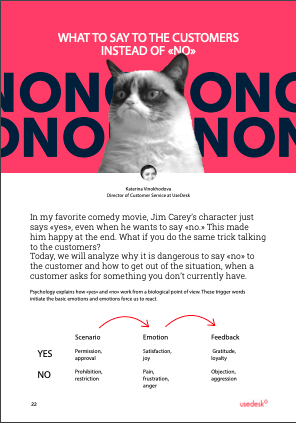Request a Demo
Send us a request for an online demonstration at the time that's convenient for you. We will give you an overview and answer any questions you may have about the system.
By clicking the button, you agree that you have read our Privacy Policy
5 CASES OF MISUNDERSTANDING THE CUSTOMERS AND A SIMPLE SOLUTION FOR EACH OF THEM
Alexandra Shiryaeva
Chief Customer Officer at UseDesk
I don't have to tell you that things with the customers don't always run smoothly: something doesn't work, is broken, or doesn't do what they want it to do. These situations are unpleasant. Any difficulties in communication with a customer don't make the customer's mood better: you tell the customer one thing, and he tells you about something else. From the other side (customer's side), it looks exactly the opposite – he keeps saying you the same thing over and over again, and you don't understand it.
The good news is that every such unpleasant situation has an amicable solution.
The good news is that every such unpleasant situation has an amicable solution.
Customer does not understand what is needed from him

— Hello! Nothing works for me.
— Hello! Just a couple of minutes, and we will figure it out. Can you describe more accurately what is not working, please?
— Nothing. I am trying to upload the files, but nothing happens.
— I see, thank you. Please, launch incognito mode (ctrl + shift + N) and try again. Let me know how it goes.
— How can I do that? — Press Ctrl + shift + N to launch incognito mode.
— I don't understand what I need to do. What do I need to press?
— Hold down ctrl + shift + N simultaneously, and a new window will open.
— Ok, I've just pressed the buttons, but nothing happened.
— (-_-)
— Hello! Just a couple of minutes, and we will figure it out. Can you describe more accurately what is not working, please?
— Nothing. I am trying to upload the files, but nothing happens.
— I see, thank you. Please, launch incognito mode (ctrl + shift + N) and try again. Let me know how it goes.
— How can I do that? — Press Ctrl + shift + N to launch incognito mode.
— I don't understand what I need to do. What do I need to press?
— Hold down ctrl + shift + N simultaneously, and a new window will open.
— Ok, I've just pressed the buttons, but nothing happened.
— (-_-)

— Hello! Nothing works for me.
— Hello! Just a couple of minutes, and we will figure it out. Can you describe more accurately what is not working, please?
— Nothing. I am trying to upload the files, but nothing happens.
— I see, thank you. Please, launch incognito mode (ctrl + shift + N) and try again. Let me know how it goes.
— How can I do that?
— Locate on the keyboard the keys marked as ctrl, shift, and N, and then press them simultaneously. A new browser window will open in incognito mode, which we need. If nothing happens, follow these instructions: https://support.google.com/chrome/answer/95464?hl=ru&co=GENIE.Platform%3DDesktop. Once a new window opens, log in to Product.ru and try to upload the photo again. I'll be here – let me know how it went.
— Hello! Just a couple of minutes, and we will figure it out. Can you describe more accurately what is not working, please?
— Nothing. I am trying to upload the files, but nothing happens.
— I see, thank you. Please, launch incognito mode (ctrl + shift + N) and try again. Let me know how it goes.
— How can I do that?
— Locate on the keyboard the keys marked as ctrl, shift, and N, and then press them simultaneously. A new browser window will open in incognito mode, which we need. If nothing happens, follow these instructions: https://support.google.com/chrome/answer/95464?hl=ru&co=GENIE.Platform%3DDesktop. Once a new window opens, log in to Product.ru and try to upload the photo again. I'll be here – let me know how it went.
The difference between the first and second conversations is that in the first example, we keep telling the customer what needs to be done, while either the instructions do not make sense to him, or he does not understand which actions from his side are required. Hence, repeating the same thing will not help. In this scenario, two possible solutions are available: do what is needed on behalf of a customer (TeamViewer, etc.), or provide clear instructions that eliminate any questions (suggest an additional explanation or alternative way to achieve the same results, etc.).
As soon as you notice that the customer does not understand your request, do not test his patience, and take the situation into your own hands and control it.
As soon as you notice that the customer does not understand your request, do not test his patience, and take the situation into your own hands and control it.
Customers want you to do something for them

— Hello! I need to upload the photos. Here are the files. It's urgent. Can you please do it for me?
— Hello! Here is how to upload the photos: …
— (Т_Т)
— Hello! Here is how to upload the photos: …
— (Т_Т)

— Hello! I need to upload the photos. Here are the files. It's urgent. Can you please do it for me?
— Hello! We do not have the right to upload the users' content for our users, but I can help you figure out how to upload your photos. We will do it together within moments.
Here is a brief instruction on how it works: … And I made a couple of screenshots so that it is easier to understand: … Please try following the guidance and let me know if it worked. I'll be here to help you promptly.
— Hello! We do not have the right to upload the users' content for our users, but I can help you figure out how to upload your photos. We will do it together within moments.
Here is a brief instruction on how it works: … And I made a couple of screenshots so that it is easier to understand: … Please try following the guidance and let me know if it worked. I'll be here to help you promptly.
Giving a customer a fishing rod, not a fish, is very important; otherwise, you may break your neck trying to deal with all of those customers who do not want to work with the product by themselves. How to give a rod is another question. We cannot just throw the instructions into the client because this will result in the following:
a) Disappointment of an unfulfilled request.
b) Conjectures. You reject doing something for the customer because you do not want to do it.
c) Annoyance caused by a "canned response."
To avoid this, explain to a customer why you cannot do this, and provide comprehensive support, showing that you do care but cannot break the rules.
a) Disappointment of an unfulfilled request.
b) Conjectures. You reject doing something for the customer because you do not want to do it.
c) Annoyance caused by a "canned response."
To avoid this, explain to a customer why you cannot do this, and provide comprehensive support, showing that you do care but cannot break the rules.
Works for everyone except for one

— Hello! I cannot upload the photos.
— Hello! I checked everything under your account – it works fine. I do not have any similar issues with other users. Let's do this. Please repeat the same steps in incognito mode (ctrl + shift + N), and let me know how it goes. It's most likely a cache issue. If the problem remains, please open Product.ru in another browser and check if the upload feature works there.
— I did all of that, but nothing helped.
— Unfortunately, there is nothing else we can do here; please try to restart your computer.
— Hello! I checked everything under your account – it works fine. I do not have any similar issues with other users. Let's do this. Please repeat the same steps in incognito mode (ctrl + shift + N), and let me know how it goes. It's most likely a cache issue. If the problem remains, please open Product.ru in another browser and check if the upload feature works there.
— I did all of that, but nothing helped.
— Unfortunately, there is nothing else we can do here; please try to restart your computer.

— Hello! I cannot upload the photos.
— Hello! I checked everything under your account – it works fine. I do not have any similar issues with other users. Let's do this. Please repeat the same steps in incognito mode (ctrl + shift + N), and let me know how it goes. It's most likely a cache issue. If the problem remains, please open Product.ru in another browser and check if the upload feature works there.
— I did all of that, but nothing helped.
— Thank you! Then we will need to investigate the issue further. Can you allow me to have access through TeamViewer to test the program and determine the causes of the problem?
— Hello! I checked everything under your account – it works fine. I do not have any similar issues with other users. Let's do this. Please repeat the same steps in incognito mode (ctrl + shift + N), and let me know how it goes. It's most likely a cache issue. If the problem remains, please open Product.ru in another browser and check if the upload feature works there.
— I did all of that, but nothing helped.
— Thank you! Then we will need to investigate the issue further. Can you allow me to have access through TeamViewer to test the program and determine the causes of the problem?
It seems reasonable not to waste time on 1 in 1,000 customers who experience some issues, especially when it is not clear what the problems are. However, in reality, it has more of ignorance rather than rationalism.
Even one customer asking for help is worthy of getting away from the routine and thinking about what can be done in his unusual situation. For example, when it comes to SaaS issues, the simplest solution is to replicate the steps on the customer's side and see the console or product show's logs, and if this does not help, then ask for support from the technical department.
On the one hand, you spend some resources, while, on the other hand, you do not leave the user alone with a non-working platform. By doing so, you will save the customers and build a reputation for fearless and sincere support.
Even one customer asking for help is worthy of getting away from the routine and thinking about what can be done in his unusual situation. For example, when it comes to SaaS issues, the simplest solution is to replicate the steps on the customer's side and see the console or product show's logs, and if this does not help, then ask for support from the technical department.
On the one hand, you spend some resources, while, on the other hand, you do not leave the user alone with a non-working platform. By doing so, you will save the customers and build a reputation for fearless and sincere support.
The customer does not provide the necessary information

— Hello! I cannot upload the photos. Everything crashes.
— Hello! Can you please send a screenshot of the error?
Three weeks later.
— Still nothing is working. Can you fix it? What do I pay for?
— Can you please send a screenshot of the error?
— Hello! Can you please send a screenshot of the error?
Three weeks later.
— Still nothing is working. Can you fix it? What do I pay for?
— Can you please send a screenshot of the error?

— Hello! I cannot upload the photos. Everything crashes.
— Hello! Please, send me a screenshot of the error so that I can see what the issue is. We'll figure it out.
— Hello! Please, send me a screenshot of the error so that I can see what the issue is. We'll figure it out.

— Hello! Nothing works for me.
— Hello! Please provide the details: what exactly is not working for you?
— I do not know what to describe – just nothing is working. I click the buttons, but they do not reflect.
— Unfortunately, I am not able to help you when I don't have any details.
— Hello! Please provide the details: what exactly is not working for you?
— I do not know what to describe – just nothing is working. I click the buttons, but they do not reflect.
— Unfortunately, I am not able to help you when I don't have any details.

— Hello! Nothing works for me.
— Hello! Please provide the details: what exactly is not working for you?
— I do not know what to describe – just nothing is working. I click the buttons, but they do not reflect.
— I see. Let's try this: Please, send me a screenshot of the entire webpage containing the buttons that do not work to locate the error. Describe the steps you are taking (for example, open the tab → go to "Upload" → click "Upload" → Nothing happens), so I can reproduce the error on my side.
Thank you so much for your attention and participation.
— Hello! Please provide the details: what exactly is not working for you?
— I do not know what to describe – just nothing is working. I click the buttons, but they do not reflect.
— I see. Let's try this: Please, send me a screenshot of the entire webpage containing the buttons that do not work to locate the error. Describe the steps you are taking (for example, open the tab → go to "Upload" → click "Upload" → Nothing happens), so I can reproduce the error on my side.
Thank you so much for your attention and participation.
It is not unusual to face the situation when the customer ignores requests for details. Often we are facing with the position – "Well, you are the customer support, and you should know what is not working for the customer." While we do not always know the issue, the customer does not have to realize this, and explaining this to the customer is not the purpose. Here, our goal is simply obtaining the information.
The two most straightforward way to obtain the information are (often they are used together):
Explain why you need the information: to help, to reproduce, to understand what happened, or to fix the issue. And so on. As soon as the customer becomes aware of your reasoning, he realizes that you can do nothing if he will not provide the additional information.
Help the customer to convert his observations into words: give him a structure that can be followed, or an example, explain in detail what you need.
The two most straightforward way to obtain the information are (often they are used together):
Explain why you need the information: to help, to reproduce, to understand what happened, or to fix the issue. And so on. As soon as the customer becomes aware of your reasoning, he realizes that you can do nothing if he will not provide the additional information.
Help the customer to convert his observations into words: give him a structure that can be followed, or an example, explain in detail what you need.
The customer does not trust you

— Hello! When will the feature of multiple photo upload become available? This is very critical to me.
— Hello! We are working on this and, I think, we will release it in the nearest future. We don't have the exact date yet.
— Well, ok, everyone says this, you could come up with something better.
— Hello! We are working on this and, I think, we will release it in the nearest future. We don't have the exact date yet.
— Well, ok, everyone says this, you could come up with something better.

— Hello! When will the feature of multiple photo upload become available? This is very critical to me.
— Hello! We are working on this and, I think, we will release it in the nearest future. We don't have the exact date yet. I know it sounds like a canned response, but we are not provided with any updates. We will keep you posted, and as soon as it is ready for release, we will distribute the informational messages.
— Hello! We are working on this and, I think, we will release it in the nearest future. We don't have the exact date yet. I know it sounds like a canned response, but we are not provided with any updates. We will keep you posted, and as soon as it is ready for release, we will distribute the informational messages.
In the conversation above, the customer pointed out that the question is critical for him, and this is a big call-out: it means he is not just wondering about this new feature, but he is interested in it. It is a well-known cliché about someone working on something that someday will be available to customers (like many other clichés, actually). Thus, you have to eliminate right away any objections, doubts, and mistrust.
If you are the first to admit that your answer is not the best one, the customer will not repeat this conclusion. It is probably very likely that he will penetrate you, and as he notices honesty in your answer, he will not be upset that much.
By the way, this approach is universal, and its formula is just like this: before sending a response, think about the apparent adverse reaction to it, and then add it to your reply. Just like when we were children: first who tells the story – \tells the truth; and it does not matter who broke that teacup from the tea set.
If you are the first to admit that your answer is not the best one, the customer will not repeat this conclusion. It is probably very likely that he will penetrate you, and as he notices honesty in your answer, he will not be upset that much.
By the way, this approach is universal, and its formula is just like this: before sending a response, think about the apparent adverse reaction to it, and then add it to your reply. Just like when we were children: first who tells the story – \tells the truth; and it does not matter who broke that teacup from the tea set.
Share with your colleagues:
Did you like this article?
Error get alias
We know a lot about customer service
Once every two weeks, we will send exciting and valuable materials about customer service - articles, cases, and system updates. Do you mind?







